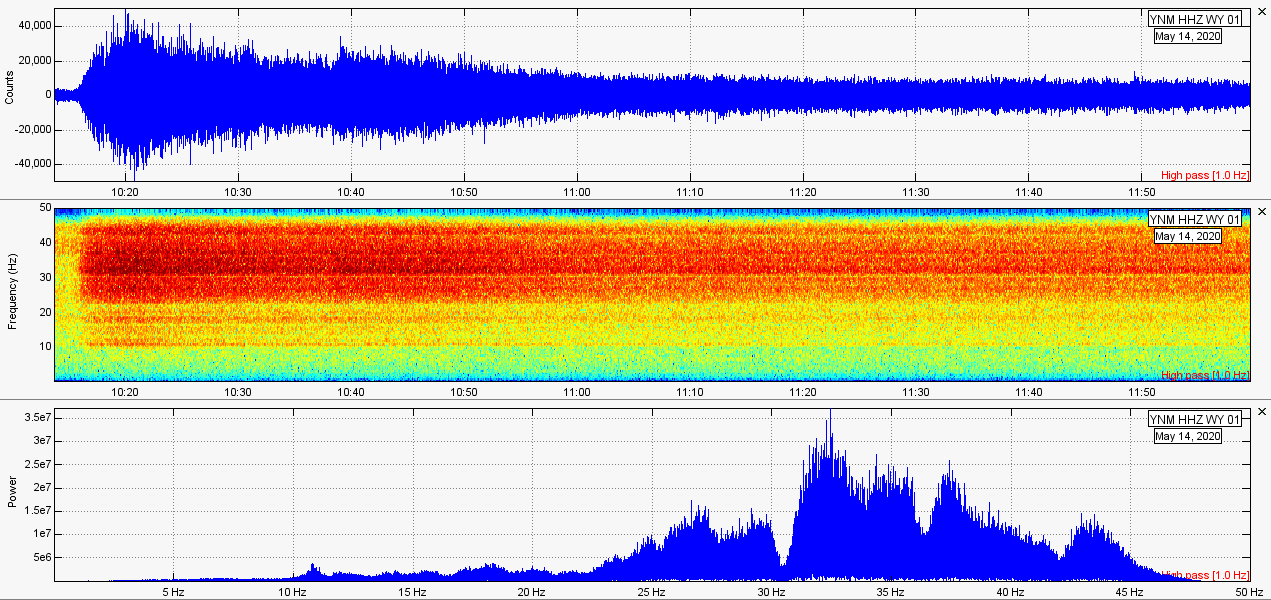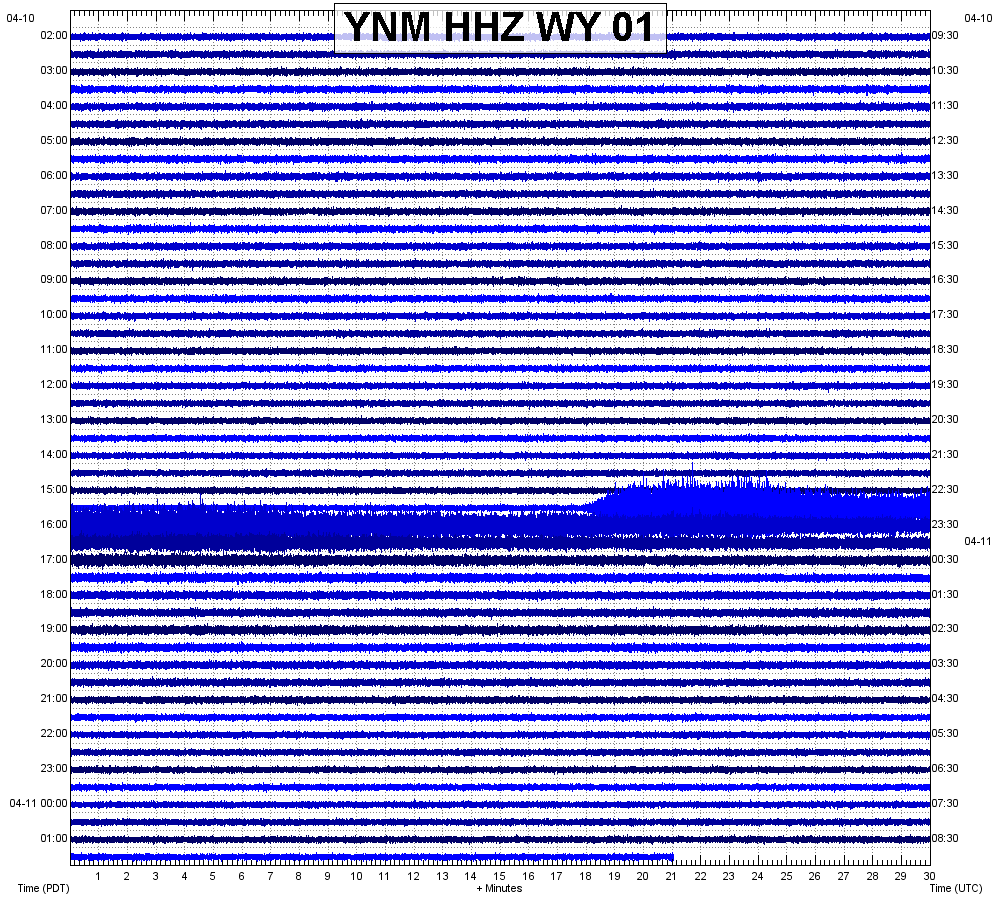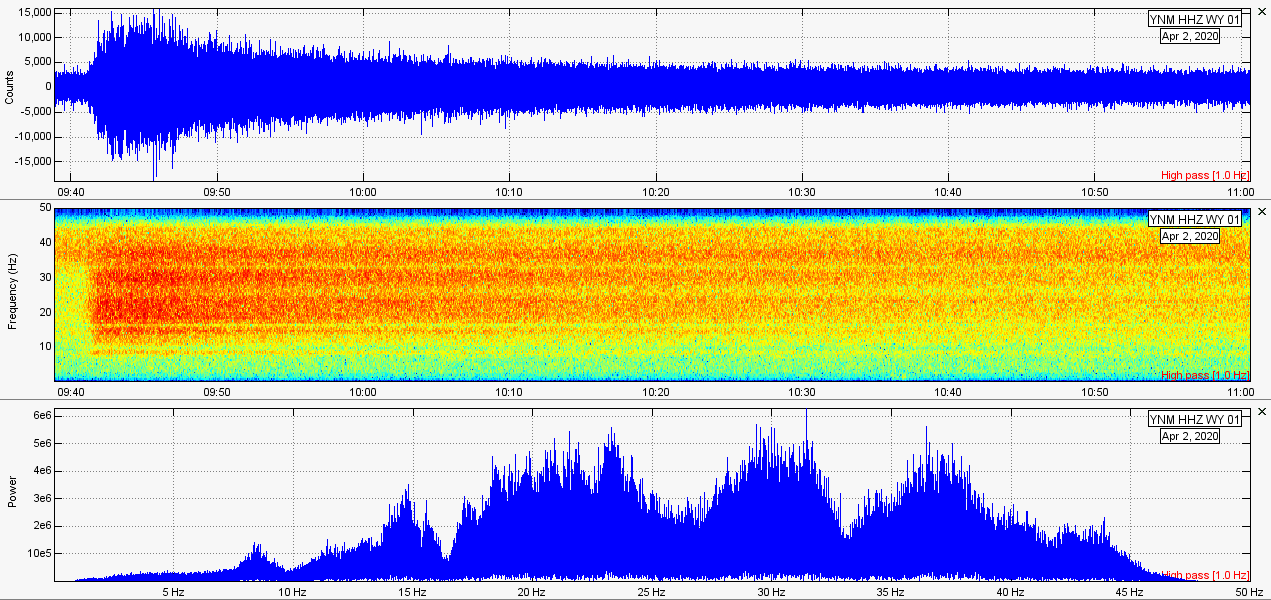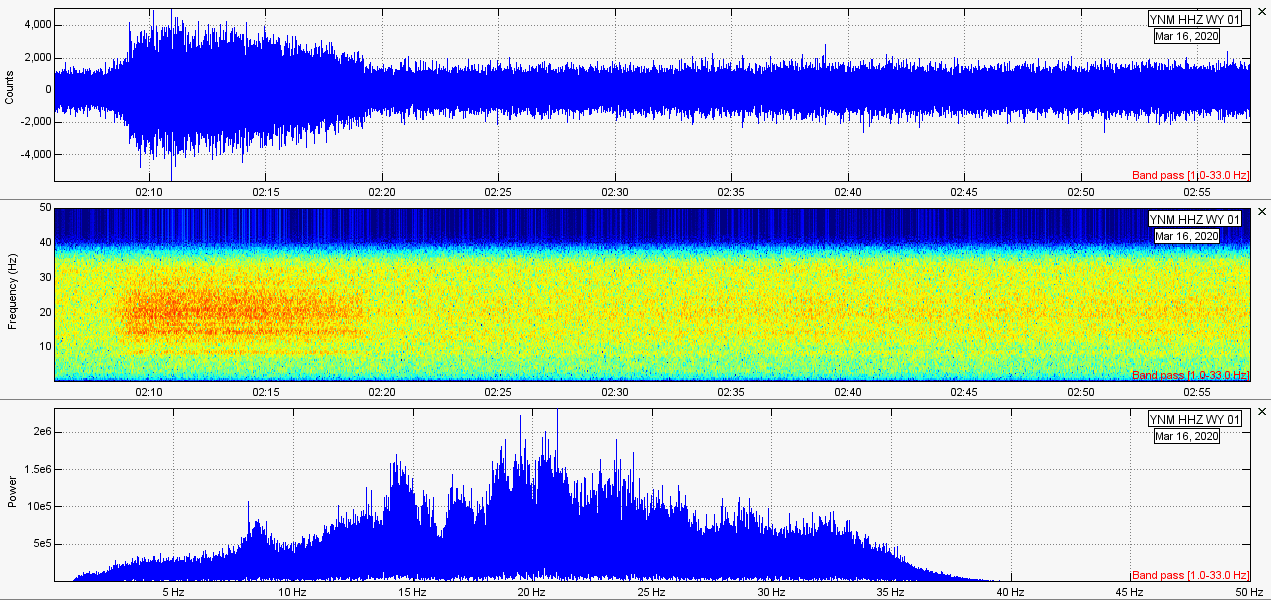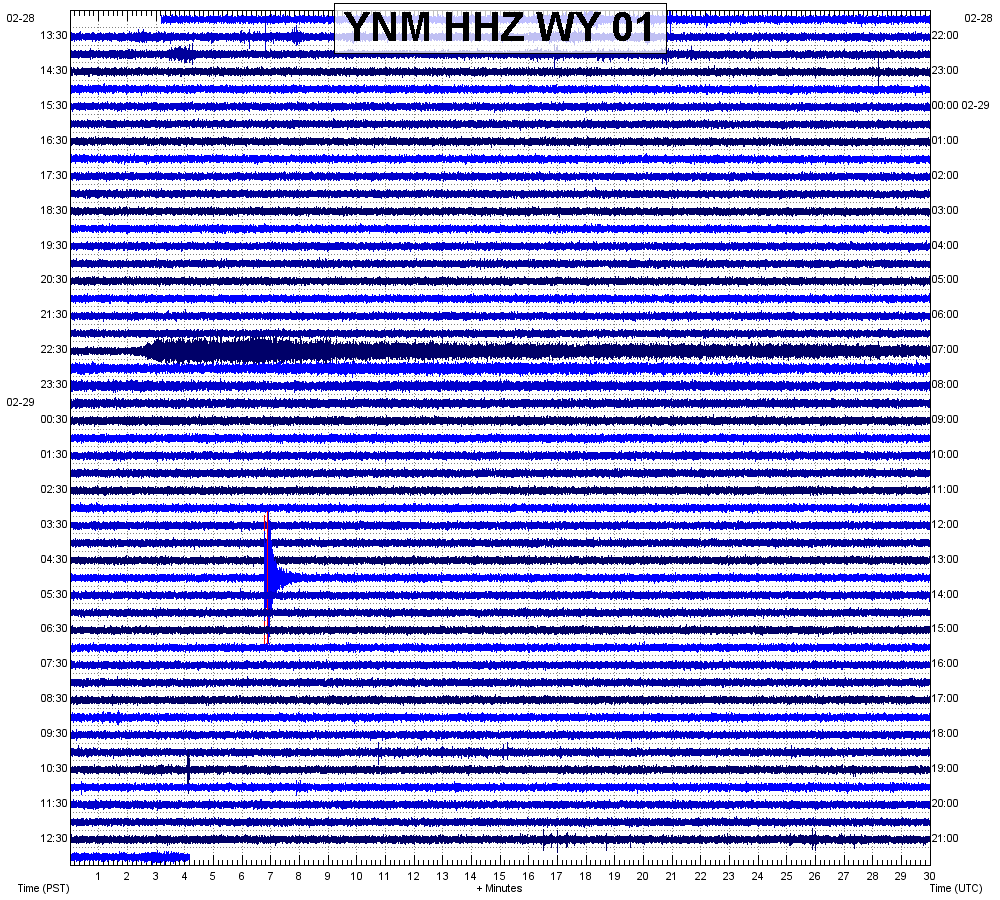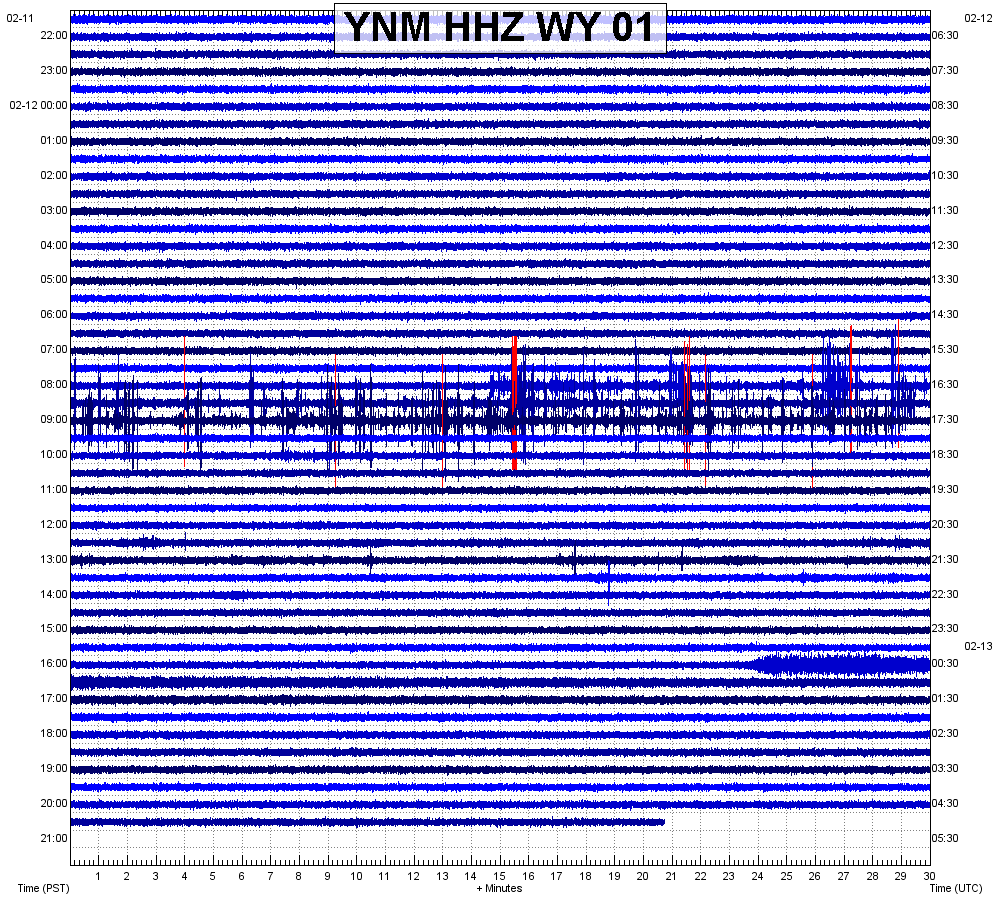2020
Steamboat Geyser is one of the world's largest hydrothermal geysers. Currently, Steamboat Geyser is the largest active geyser on the entire planet. It produces some of the largest, tallest, and longest hydrothermal eruptions known to man. It resides in the Norris Geyser Basin at the infamous super-volcano: Yellowstone National Park and Caldera. This page will show the helicorders, along with the seismogram/spectrogram/spectra plots, of every Steamboat hydrothermal eruption of the year 2019. It has been dormant for some time but miraculously sprang to life in March of 2018. The record used to be 29 eruptions in one year, which occurred in 1964. Then, on December 8, 2018, Steamboat Geyser officially beat the all-time record with 32 eruptions for 2018. Then, on August 27, 2019, Steamboat Geyser blew that record out of the water. 2019 now holds the highest count of eruptions within 1 year with a total of 48 eruptions for 2019. The entire 2018-2019 period contained 80 eruptions!!! Don't forget to stay up to date with the official 2020 Steamboat page here on my website! I will try my best to update within a few hours of every Steamboat eruption.
Now I have talked about Steamboat Geyser many times on my YouTube channel and "Seismo-Blog". I have shown numerous amounts of data pertaining to these eruptions. The seismic traces you are about to see, using many different types of data sets, are the surface vibrations from these events. If you would like to see the reasons why, please click the button above. Therefore, since the seismic stations detect the surface vibrations, you can compare the amplitude count, the "count" on the left hand side of any seismogram plot, and understand which eruptions were larger, in terms of amplitude (strength), than others. Please enjoy!
This page is for 2019 only! I will post the data in order from the oldest, at the bottom of the page, to the newest, here at the top of the page. Every time Steamboat erupts I will add the helicorder and plots from YNM, the station closest to Steamboat geyser. If you need any other data, please let me know and please check back here from time to time.
Since YNM (WY_YNM_01_HHZ) detects these eruptions best, I will use that seismic station. Remember, as always, you must read chart labels FIRST before you read the data. Time period is especially crucial when analyzing seismogram or spectrogram plots. If you keep the size of a chart the same but increase the amount of data shown within that chart, then less detail will be shown.
HEADS UP! Since some of you may be comparing the amplitude count (strength) on the seismogram plots for the eruptions, there is something you might notice that confuses you. Notice how on some of the seismogram plots the amplitude count reaches 1e5 or 1.5e5 (primarily for eruptions of 2018)? Well what does that mean? It is simple. 1e5 is a 1 followed by 5 zeroes (100,000). So 1e5 would be 100,000 amplitude count. 2e5 would be 200,000 amplitude count and 3e5 would be 300,000 amplitude count. Some traces around the world for strong quakes have shown 5e8, in other words a 5 followed by 8 zeroes (500,000,000 amplitude count). Now you may notice 1.5e5. That is simply 150,000 amplitude count. Whenever you see 1.5e5 that would be 15 followed by 4 zeroes, which would be 150,000 amplitude count. It may be a little confusing but pretty much all you need to know is 1e5=100,000 and 1.5e5=150,000. All of the following plots and helicorders were generated by me using only SWARM and the IRIS seismic archive.
Now I have talked about Steamboat Geyser many times on my YouTube channel and "Seismo-Blog". I have shown numerous amounts of data pertaining to these eruptions. The seismic traces you are about to see, using many different types of data sets, are the surface vibrations from these events. If you would like to see the reasons why, please click the button above. Therefore, since the seismic stations detect the surface vibrations, you can compare the amplitude count, the "count" on the left hand side of any seismogram plot, and understand which eruptions were larger, in terms of amplitude (strength), than others. Please enjoy!
This page is for 2019 only! I will post the data in order from the oldest, at the bottom of the page, to the newest, here at the top of the page. Every time Steamboat erupts I will add the helicorder and plots from YNM, the station closest to Steamboat geyser. If you need any other data, please let me know and please check back here from time to time.
Since YNM (WY_YNM_01_HHZ) detects these eruptions best, I will use that seismic station. Remember, as always, you must read chart labels FIRST before you read the data. Time period is especially crucial when analyzing seismogram or spectrogram plots. If you keep the size of a chart the same but increase the amount of data shown within that chart, then less detail will be shown.
HEADS UP! Since some of you may be comparing the amplitude count (strength) on the seismogram plots for the eruptions, there is something you might notice that confuses you. Notice how on some of the seismogram plots the amplitude count reaches 1e5 or 1.5e5 (primarily for eruptions of 2018)? Well what does that mean? It is simple. 1e5 is a 1 followed by 5 zeroes (100,000). So 1e5 would be 100,000 amplitude count. 2e5 would be 200,000 amplitude count and 3e5 would be 300,000 amplitude count. Some traces around the world for strong quakes have shown 5e8, in other words a 5 followed by 8 zeroes (500,000,000 amplitude count). Now you may notice 1.5e5. That is simply 150,000 amplitude count. Whenever you see 1.5e5 that would be 15 followed by 4 zeroes, which would be 150,000 amplitude count. It may be a little confusing but pretty much all you need to know is 1e5=100,000 and 1.5e5=150,000. All of the following plots and helicorders were generated by me using only SWARM and the IRIS seismic archive.
The most recent Steamboat Geyser eruption is the 15th eruption of 2020 (the 95th eruption since it reactivated in early-2018 and the 63rd eruption since the start of 2019). Eruptions seem to be gradually intensifying, much like it did many time since it re-activated in 2018.
Steamboat still seems to be alive and well. Will 2020 beat the record from 2019? Probably not, but you never know!
I am trying to update this as much as possible, but I have been extremely busy lately. Regardless, keep an eye on stations YNM and YNR for Steamboat eruptions and I will try to update this page as soon as I can. Steamboat is still alive and it will take at least 3 months of no eruptions for me to think Steamboat is asleep, as it has gone to sleep in the past.
Steamboat still seems to be alive and well. Will 2020 beat the record from 2019? Probably not, but you never know!
I am trying to update this as much as possible, but I have been extremely busy lately. Regardless, keep an eye on stations YNM and YNR for Steamboat eruptions and I will try to update this page as soon as I can. Steamboat is still alive and it will take at least 3 months of no eruptions for me to think Steamboat is asleep, as it has gone to sleep in the past.
15th eruption of 2020 occurred at 02:11UTC on May 20, 2020 (8:11pm Mountain Time, May 19, 2020):
14th eruption of 2020 occurred at 10:16UTC May 14, 2020 (4:16am Mountain Time, same date):
13th eruption of 2020 occurred at 07:05UTC May 8, 2020 (NOTE: station YNR had to be used since YNM was offline during this time; 1:05am Mountain Time, same date):
12th eruption of 2020 occurred at 22:21UTC April 27, 2020 (4:21pm Mountain Time, same date):
11th eruption of 2020 occurred at 22:47UTC April 10, 2020 (4:47pm Mountain Time, same date):
10th eruption of 2020 occurred at 09:41UTC April 2, 2020 (3:41am Mountain Time, same date):
9th eruption of 2020 occurred at 03:17UTC March 25, 2020 (9:17pm Mountain Time, March 24, 2020):
8th eruption of 2020 occurred at 02:08UTC March 16, 2020 (8:08pm Mountain Time, March 15, 2020):
7th eruption of 2020 occurred at 01:37UTC March 7, 2020 (6:37pm Mountain Time, March 6, 2020):
6th eruption of 2020 occurred at 06:32UTC Feb. 29, 2020 (11:32pm Mountain Time, Feb. 28, 2020):
5th eruption of 2020 occurred at 08:36UTC Feb. 21, 2020 (1:36am Mountain Time, same date):
4th eruption of 2020 occurred at 00:23UTC February 13, 2020 (5:23pm Mountain Time, February 12, 2020):
3rd eruption of 2020 occurred at 04:07UTC February 2, 2020 (9:07pm Mountain Time, February 1, 2020):
2nd eruption of 2020 occurred at 01:24UTC January 24, 2020 (6:24pm Mountain Time, January 23, 2020):
1st eruption of 2020 occurred at 02:45UTC January 10, 2020 (7:45pm Mountain Time, January 9, 2020):



